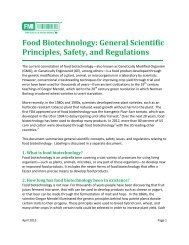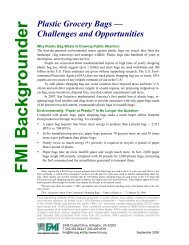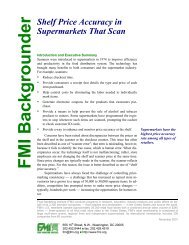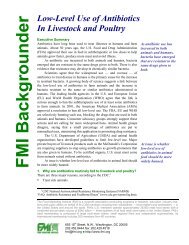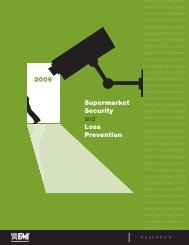Global Commerce Initiative EPC Roadmap - GlobalScorecard.net
Global Commerce Initiative EPC Roadmap - GlobalScorecard.net
Global Commerce Initiative EPC Roadmap - GlobalScorecard.net
You also want an ePaper? Increase the reach of your titles
YUMPU automatically turns print PDFs into web optimized ePapers that Google loves.
<strong>Global</strong> <strong>Commerce</strong> <strong>Initiative</strong> <strong>EPC</strong> <strong>Roadmap</strong><br />
2.3 <strong>EPC</strong> Architecture<br />
A key component of the <strong>EPC</strong> <strong>net</strong>work are<br />
inexpensive tags and readers passing small bits of<br />
information or the <strong>EPC</strong> while leveraging the Inter<strong>net</strong><br />
to hold large amounts of information that can be<br />
shared between trading partners. The goal of the<br />
<strong>EPC</strong> <strong>net</strong>work is to allow computers to sense<br />
products automatically and make intelligent<br />
decisions about them. The <strong>net</strong>work seeks to provide<br />
a streamlined method for discovering significant<br />
product details quickly in order to allow computers<br />
to monitor, decide, and take action without human<br />
intervention.<br />
The <strong>EPC</strong> <strong>net</strong>work is based on the following principles:<br />
• Inexpensive tags and readers that conform to a<br />
standard specification and to the local air<br />
interface protocols, which vary depending on<br />
country or region.<br />
• Minimum information stored on the tag. Under<br />
the pure <strong>EPC</strong> vision, the only information stored<br />
on the tag would be the <strong>EPC</strong> number.<br />
• The use of software — called a savant — to act<br />
as a connecting layer between the reader and<br />
applications to filter the <strong>EPC</strong> data and pass on<br />
only appropriate product movement information<br />
to application systems.<br />
• Information related to each object is securely<br />
stored on a public <strong>net</strong>work with the appropriate<br />
security controls. It can be accessed when<br />
required through the services of an object<br />
naming service (ONS) that points to a computer<br />
where the information about the object is held.<br />
The <strong>EPC</strong> information service (<strong>EPC</strong>IS) on that<br />
computer will provide a description of the<br />
product in physical markup language (PML).<br />
• Interoperable tags and readers are based on an<br />
open, global standards-based system. These<br />
standards ensure that any <strong>EPC</strong>-compliant tags<br />
can be read by any <strong>EPC</strong>-compatible reader and<br />
that a tag applied in one country should work in<br />
any other country.<br />
2.3.1 <strong>EPC</strong> Numbering Scheme<br />
At the very heart of the <strong>EPC</strong> <strong>net</strong>work is an<br />
identification standard. Just as every car today has a<br />
unique vehicle identification number, each item<br />
manufactured in the future will have an <strong>EPC</strong>. This<br />
unique serial number will have the flexibility to allow<br />
the <strong>EPC</strong> <strong>net</strong>work to track shipments, pallets, cases, or<br />
individual items throughout an entire supply chain.<br />
The <strong>EPC</strong> number is made up of four key elements:<br />
• The header defines the overall number length of<br />
the <strong>EPC</strong>, including the number, type, version, and<br />
length of the subsequent partitions.<br />
• The <strong>EPC</strong> manager is the company or entity<br />
responsible for managing the subsequent codes.<br />
Existing Applications Integrating with <strong>EPC</strong> Components<br />
<strong>EPC</strong> Components<br />
Existing Applications<br />
4<br />
2.3.4<br />
<strong>EPC</strong>IS SERVER<br />
ONS SERVER<br />
ENTERPRISE APPLICATIONS<br />
(Inventory Management,<br />
Supply Chain Management,<br />
Planning, Merchandising, Transportation, etc.)<br />
2.3.3<br />
2.3.2<br />
<strong>EPC</strong><br />
SAVANT<br />
<strong>EPC</strong><br />
READER SYSTEM<br />
Integration Layer<br />
LOCAL APPLICATIONS<br />
(Warehouse Management System,<br />
Point-of-Sale Systems)<br />
TAG<br />
2.3.1<br />
The <strong>EPC</strong> Number<br />
01.203D2A9.168B8.719BAE03C<br />
Source: IBM Business Consulting Services<br />
10 © Copyright November 2003, <strong>Global</strong> <strong>Commerce</strong> <strong>Initiative</strong>/IBM




